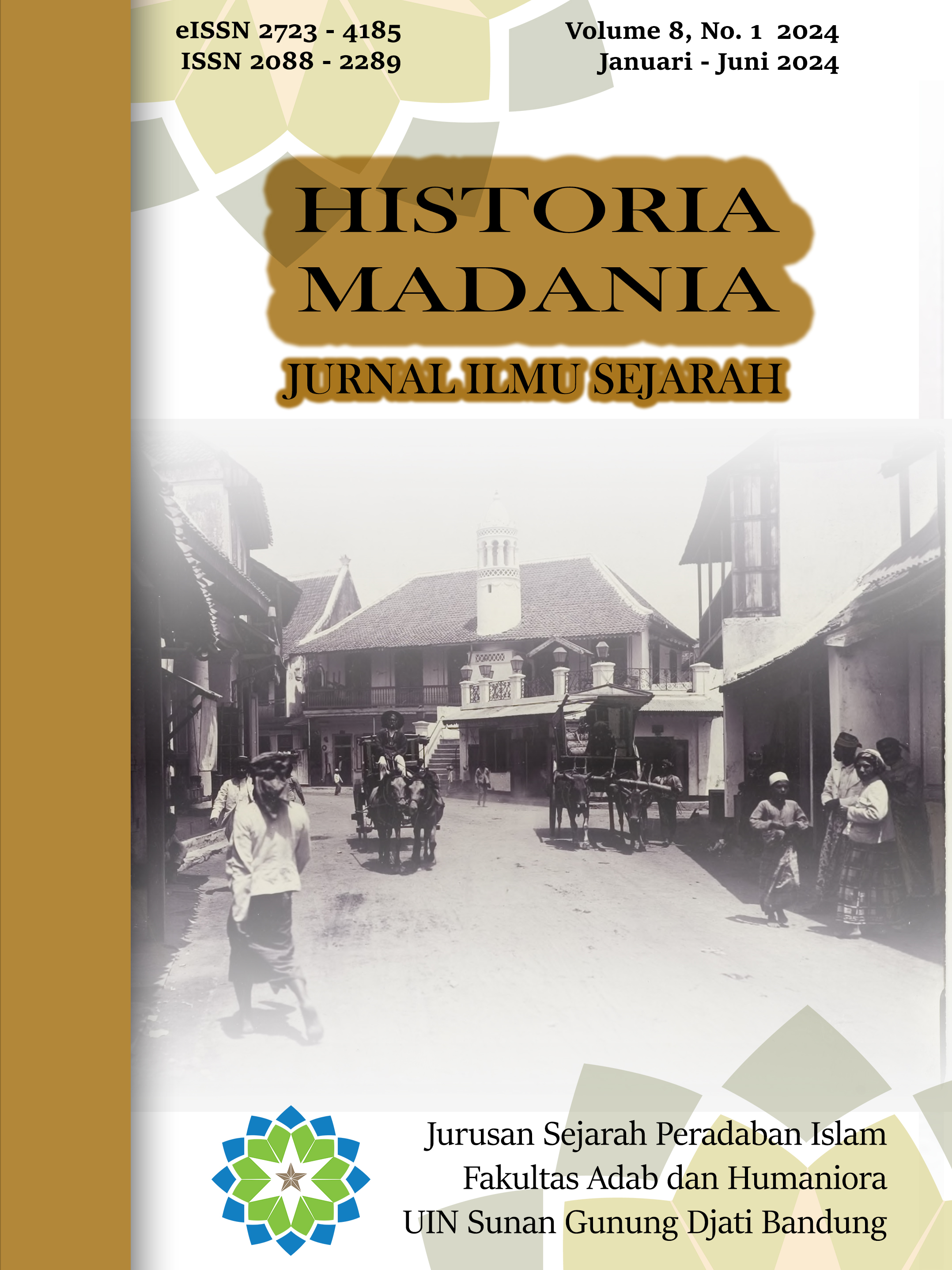Gelandangan Kepung Kota Semarang, 1950-1964: Kedatangan, Kehidupan, dan Penanggulangan
DOI:
https://doi.org/10.15575/hm.v8i1.33366Abstract
The This research examines the phenomenon of homelessness in Semarang throughout 1950-1964 with a problem formulation, (a) what is the process of the rise of homelessness in Semarang City? (b) how do homeless people survive amidst the tumultuous economy in Semarang?, (c) what are the government's efforts to solve this problem? The research method used is a historical research method consisting of heuristics, source criticism, interpretation and historiography. Primary sources used include contemporary newspapers such as Suara Merdeka in 1954th and 1964th, the locomotive 1950th and 1955th, the Preangerbode 1953th, democratic socialist daily newspaper in 1962th. Additionally This research is also supported by secondary sources in the form of previous study literature. The results of this research show that this phenomenon is caused by urbanization, economic competition and disasters. They live and live uncertainly. The government has tried to provide compensation, provide housing camps, including plans to transmigrate homeless people outside Java to solve this problem.
Â
Keywords: homeless, social, Semarang city.
References
“Grote Brand In Semarang.†1963. Algemeen Indisch Dagblad: De Preangerbode. Bandoeng. September 30, 1963. https://resolver.kb.nl/resolve?urn=ddd:010896960:mpeg21:p002.
De Locomotief: Samarangsch Handels- En Advertentie-Blad. 1955. “Ongeveer Drieduizend Daklozen in Semarang,†January 27, 1955. https://resolver.kb.nl/resolve?urn=ddd:011178220:mpeg21:p002.
De Tijd : Dagblad Voor Nederland. 1969. “Zwervers Worden Opgeruimd Mensen Lopen Stuk In Grote Steden Indonesie Wrrkt Aan Zyn Toekomst Door Fons Van Westerloo,†September 20, 1969. https://resolver.kb.nl/resolve?urn=ddd:011238523:mpeg21:p017.
Het Vrije Volk: Democratisch-Socialistisch Dagblad. 1962. “Overstroming in Midden-Java,†November 6, 1962. https://resolver.kb.nl/resolve?urn=ddd:010953986:mpeg21:p015.
Kasmadi, Hartono, and Wiyono. 1985. Sejarah Sosial Kota Semarang 1900-1950. 1985: Departemen Pendidikan dan Kebudayaan RI.
Mahesa, Sheila Putri. 2021. “Kehidupan Sosial Ekonomi Kawasan Kota Lama Semarang Tahun 2003-2018.†Journal Pendidikan Sejarah 10 (3).
Pradipta, Mahatma Nandi Wardhana, and Andy Suryadi. 2021. “Survivalitas Pedagang Gilo-Gilo Semarang Tahun 1960-2000.†Journal of Indonesian History 10 (2): 141–54. http://journal.unnes.ac.id/sju/index.php/jih.
Ridlo, Mohammad, Agung. 1996. “Mengupas Problema Kota Semarang Metropolitan.†https://www.researchgate.net/publication/320704285.
Salawati, A, R., and A Purnomo. 2021. “Gelandangan Pada Masa Revolusi Kemerdekaan Di Semarang Tahun 1945-1950.†Journal of Indonesian History 10 (2): 179–1990.
Suara Merdeka. 1954. “Razzia Dibawah Terang Bulan,†June 17, 1954.
Suara Merdeka. ———. 1964. “DPRD-GR Semg. Mulai Bitjarakan Soal Gelandangan,†February 6, 1964.
Suara Merdeka. ———. 1965. “Glandangan2 Di Smg. Akan Diberi Tanda ‘Penning,’†December 2, 1965.
Tio, Jonkie. 2001. Kota Semarang Dalam Kenangan. . Surabaya: Jawa Pos.
Widja, I Gede. 1989. Sejarah Lokal Suatu Prespektif Dalam Pengajaran Sejarah. Jakarta: Departemen Pendidikan dan Kebudayaan RI.
Downloads
Additional Files
Published
How to Cite
Issue
Section
Citation Check
License
Authors who publish with this journal agree to the following terms:
- Authors retain copyright and grant the journal right of first publication with the work simultaneously licensed under a Creative Commons Attribution License that allows others to share the work with an acknowledgment of the work's authorship and initial publication in this journal.
- Authors are able to enter into separate, additional contractual arrangements for the non-exclusive distribution of the journal's published version of the work (e.g., post it to an institutional repository or publish it in a book), with an acknowledgment of its initial publication in this journal.
- Authors are permitted and encouraged to post their work online (e.g., in institutional repositories or on their website) prior to and during the submission process, as it can lead to productive exchanges, as well as earlier and greater citation of published work (See The Effect of Open Access).


